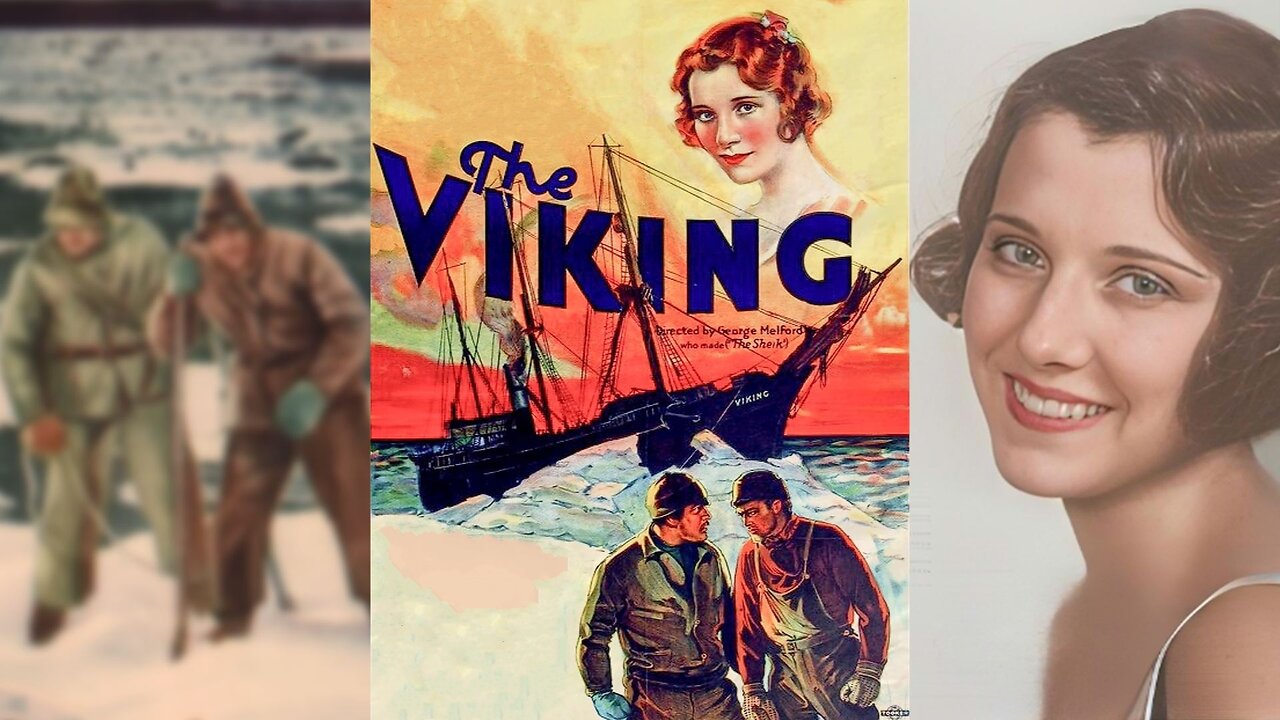Premium Only Content

THE VIKING (1931) Charles Starrett & Louise Huntington | Adventure, Drama, Romance | B&W
he Viking (French: Ceux du Viking), also known as White Thunder and Vikings of the Ice Field, is a 1931 Newfoundland/American adventure film about sealing directed by George Melford. The Viking was the first film to record sound and dialogue on location with the use of magnetic wire recording. It is best known for the explosion aboard the ship SS Viking (an actual sealing ship) during filming, in which many members of the crew, including producer Varick Frissell, were killed. It remains the incident with the largest loss of life in film history.
SYNOPSIS
Luke, a young sailor and fisherman, who thinks he is jinx-ridden, has to be persuaded, and taunted,before he will join a sealing-expedition in the Artic; first by his sweetheart, so he can find that he is not a jinx, and also by Jed, who has a devious reason.
Set on the coast of Newfoundland, a rivalry develops between Jed Nelson, a seal hunter, and Luke Oarum, a local man considered a jinx. Worried that his rival may try to steal his girlfriend Mary Joe, calling him a coward, the seal hunter goads Luke into accompanying him on an Arctic sealing expedition on Viking, commanded by Capt. Barker. They both end up in a hunting party on the ice floes and eventually find themselves stranded. Jed tries to kill Luke, but the snow blinds him and his gunshot misses.
Despite the attempt on his life, Luke helps walk the blinded Jed across the ice floes back to Newfoundland after they are unable to return to the ship.
CAST & CREW
Louise Huntington as Mary Joe
Charles Starrett as Luke Oarum
Capt. Robert Abram Bartlett as Capt. Barker
Arthur Vinton as Jed Nelson
Directed by George Melford, Varick Frissell
Written by Garnett Weston (scenario and dialogue), Story by Garnett Weston
Produced by Varick Frissell
Cinematography Alfred Gandolfi, Maurice Kellerman, Alexander G. Penrod
Edited by H. P. Carver
Production company J.D. Williams, Newfoundland-Labrador Film Company
Distributed by J.D. Williams
Release dates March 5, 1931 (Newfoundland), June 21, 1931 (United States)
Running time 70 min.
Country Newfoundland, United States
Language English
NOTES
American-born producer Varick Frissell's previous short films, The Lure of Labrador and The Swilin' Racket (also known as The Great Arctic Seal Hunt), prompted him to make a full-length feature entitled Vikings of the Ice Field. Paramount Pictures put up $100,000 to finance the production, while insisting that Hollywood personnel be used. Frissell hired director George Melford, who had attended McGill University in Montreal and had experience in filming Canadian subjects previously.
By 1930, Frissell had completed most of the principal photography on location in Quidi Vidi. For realistic footage, Frissell then took his crew to the Grand Banks and Labrador to film action sequences. The film was privately shown at the Nickel Theatre at St. John's on March 5, 1931. After this screening, Frissell decided that his film needed more real scenes from the Labrador ice floes. Within days, Frissell and his crew had joined the SS Viking for its annual seal hunt. The ship got trapped in ice near the Horse Islands.
On March 15, 1931, while trying to film an iceberg, Frissell, Alexander Penrod, 25 crew members and a stowaway were killed in an explosion. Some of the survivors made the over-ice trek to the Horse Islands, while others were rescued by vessels dispatched to the area.
Despite the fatal accident, the film was completed and released in June 1931. The title was changed from White Thunder to The Viking. A French-language version Ceux du Viking was released in 1932.
Reviews for The Viking varied, while the story was generally panned. The New York Times review referred to the film's story as "sketchy". The reviewer, however, noted: "'The Viking', like Mr Varick's silent work, 'The Swilin' Racket', has many marvelous scenes of the ice fields and of the adventures of men on a seal hunt off Labrador. It is enhanced by being made with sound effects, but the dialogue, like the story, is merely incidental."
The Theater Guild Magazine found the story "melodramatic" and the screenplay uninteresting in comparison to the cinematography. The Film Daily gave a negative review, noting the "weakness" of the story.
White Thunder, a National Film Board documentary on Varick Frissell's life, directed by Newfoundlander Victoria King, was released in 2002.
-
 2:26
2:26
Lost n Found Films
15 days agoFOURTH OF JULY GIVEAWAY!
120 -
 43:26
43:26
Kimberly Guilfoyle
1 hour agoRestoring the American Dream, Live with Tony Kinnett & Adam Weiss | Ep238
2.08K5 -
 1:47:44
1:47:44
vivafrei
5 hours agoLive w/ Mike Benz! Was Epstein an Intelligence Tool? Maurene Comey FIRED? Ostrich Farm UPDATE & MORE
71.9K22 -
 LIVE
LIVE
Candace Show Podcast
1 hour agoThe Epstein Files: The Midas Touch | Ep 1
3,985 watching -
 2:57:38
2:57:38
The Quartering
3 hours agoRFK Gets Big Win, A "Disney Adults" Dating App, CEO Exposed At Concert & Live Action Assassins Creed
117K16 -
 LIVE
LIVE
Sarah Westall
59 minutes agoQuantum Physics: The Blueprint that Bridges Science, Spiritualty & Reality w/ Ian Mitchell & Philipp
97 watching -
 40:47
40:47
Members Club
3 hours agoAngel Reese, Disabled Barbie, and the Death of Standards - MC03
15 -
 9:13
9:13
WhaddoYouMeme
2 hours agoI Watched Superman (2025)…It Exposed Us
1233 -
 LIVE
LIVE
LFA TV
20 hours agoLFA TV ALL DAY STREAM - THURSDAY 7/17/25
1,485 watching -
 4:01:50
4:01:50
Barry Cunningham
16 hours agoMUST WATCH: KAROLINE LEAVITT HOSTS WHITE HOUSE PRESS CONFERENCE!
51.6K21